The Porsche Cayman Buyers Guide
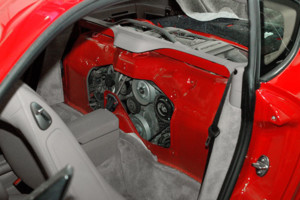 Thinking of buying a Porsche Cayman? Our Porsche Cayman buyers guide highlights potential mechanical issues to be aware of before you buy a 987, 981 or 718 Porsche Cayman.
Thinking of buying a Porsche Cayman? Our Porsche Cayman buyers guide highlights potential mechanical issues to be aware of before you buy a 987, 981 or 718 Porsche Cayman.
If you’re in the market for a used Porsche Cayman, our guide will help you find the bargain and avoid the bad investment. There’s no fluff or niceties here – there are plenty of resources online that bash on about horse power, cosmetic variants, historical significance and the niceties of the Cayman. All well and good, but how do you tell a good mechanical Cayman from a bad one? What are the potential pitfalls? What known problems exist and how do you avoid them? We have the answers you need.
We concentrate on the technical things that might cost you money later if you weren’t aware of them prior to buying the car. There are risks if you’re not cautious, but with some insights and careful shopping, there are bargains to be had.
What do we know about the Porsche Cayman so far?
After the success of the 986 Boxster, Porsche introduced the 987 platform in 2005 with a coupe version known as the Cayman. Mid-engine and more than just a hard-topped Boxster, the Porsche Cayman is properly balanced and enjoys a stiffer feel than the Boxster on the race track. It’s ideal for those who aren’t soft top fans and its well-mannered balance is more forgiving than its 911 cousins.
The Porsche Cayman platform exists right up to the current production 718. As a result, there’s extensive knowledge available of common mechanical problems with these cars. The good news is the Cayman is generally reliable and has aged gracefully.
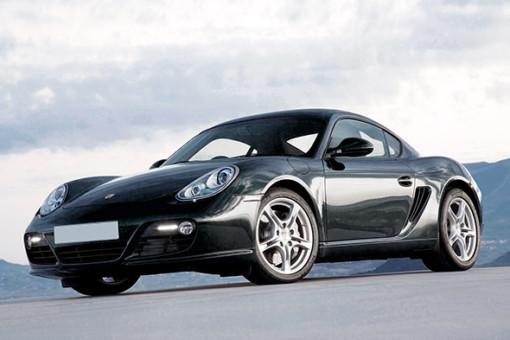
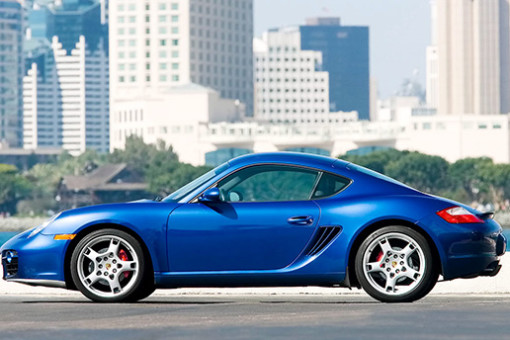
The mid-engine coupe is bags of fun, well balanced and has pretty forgiving handling. The Cayman displays good manners, is responsive and easy to drive. Maintenance and running costs are at the low end of the Porsche ownership scale. Mechanically, the design is generally solid, with the exception of a few items highlighted below.
In the used car market, you’ll find Porsche Cayman 987 (2005-2012), 981 (2012-2016) and current 718 versions available. Prices vary, however, in general the Cayman is a bargain, with 987 models at very affordable prices. All models have their own unique set of problems, however, as the Cayman has matured, there are definitely less catastrophic potential problems with the later versions. That doesn’t mean ignore the early versions, it simply means more caution is required.
Excellence Magazine recently published an interesting article related to a European road trip in a 2006 Porsche Cayman that the author had bought for just $14,000 – a lot of car for a great price.
Porsche Cayman Spare Parts and Repairs
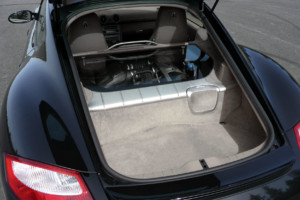 The Cayman is easy to upgrade from both a performance or cosmetic stand point. It shares much of the 911 series parts, so availability of replacement components is easy. Most are readily available directly from Porsche and a healthy used parts market exists to fill the gaps. There are plenty of third-party parts vendors online that can offer parts at lower cost than Porsche directly.
The Cayman is easy to upgrade from both a performance or cosmetic stand point. It shares much of the 911 series parts, so availability of replacement components is easy. Most are readily available directly from Porsche and a healthy used parts market exists to fill the gaps. There are plenty of third-party parts vendors online that can offer parts at lower cost than Porsche directly.
There is also a good deal of experience and expertise in independent Porsche repair shops to help make the maintenance of your used Cayman cost effective.
Porsche Cayman Maintenance Costs
You’re buying a Porsche, so don’t compare running costs to a small domestic hatchback! Yes, parts and some labor costs will be higher than a typical American or Japanese vehicle. However, save for a few notable items discussed below, the Cayman is solid and reliable. If you’re between Cayman or Boxster, the most obvious cosmetic upside with the Cayman, is the lack of maintenance required to a convertible top. This can be a big money saver.
You’re going to pay a little more for an oil change and standard maintenance items, however, don’t try to cheap these. It’s important to have the car inspected and serviced by a professional with genuine Porsche expertise. A good mechanical understanding of these cars can help identify issues early and save you money in the long term. See our guide to Porsche repair shops for your local expert or contact us and we’ll make a recommendation for you.
Porsche Cayman Maintenance Schedule
It’s important to understand where the Cayman you’re considering buying falls within it’s recommended maintenance schedule. Maintenance schedules are based on mileage and elapsed time. Compare the known maintenance history of the Porsche Cayman with our maintenance schedules. This should enable you to better understand the asking price, the near future maintenance requirements of the car and perhaps help identify a well maintained Cayman from a neglected one.
Buying a 7 year old Porsche Cayman and not realizing a major maintenance spend is due in the 8th year, is not the smartest thing you can do!
Pre-purchase Inspection
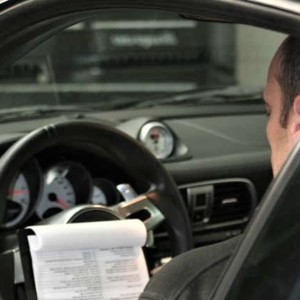 The first step, once you’ve identified a candidate, is to get a thorough inspection by a local Porsche expert. The pre-purchase inspection is designed to identify mechanical problems that may not be clearly evident at first glance. In our buyer guide below we’ve extensively highlighted those potential issues to be on the look out for. Getting a repair history on the car, if available, is helpful and will instantly identify or eliminate potential problem areas.
The first step, once you’ve identified a candidate, is to get a thorough inspection by a local Porsche expert. The pre-purchase inspection is designed to identify mechanical problems that may not be clearly evident at first glance. In our buyer guide below we’ve extensively highlighted those potential issues to be on the look out for. Getting a repair history on the car, if available, is helpful and will instantly identify or eliminate potential problem areas.
The number of owners doesn’t necessarily matter with a Cayman – the work and records performed do. Many owners are enthusiasts and will keep all the invoices from services or repairs. If a seller wont let you inspect the car, walk away.
Mileage and Service History
On cars approaching 15 years old, higher mileage is not necessarily a bad thing. In fact, a Cayman that has been well used, could be in a better condition than one that has an attractively low mileage reading. Low mileage cars can have hidden issues.
You’ll want to take a good look through any documented history available. A clear pattern of servicing on higher mileage cars is essential. On the lower mileage cars, timed intervals between service is the key thing to look for.
Low Mileage Garage Queen – Not So Fast!
Its’ always great to find a low mileage car, however, the lack of driving can present a different set of challenges to those of cars that average 10K miles per year. Low mileage cars can miss their standard service intervals. This can cause time related degradation of the service items to be overlooked. A lack of mileage still causes wear and tear in items such as fluids, tires, brakes, clutch surfaces and oil seals. Look to see when the last time the spark plugs were changed – 10 years is the limit regardless of mileage. The brake fluid should be flushed every 2 or 3 years. Check the DOT on the tires – lots of tread doesn’t mean they are robust – See more items below.
Clearly, low mileage cars attract more money for the purchase, but make sure you plan supplemental budget to bring the service work up to date after you own the car.
What’s a Porsche Cayman Like to Live With?
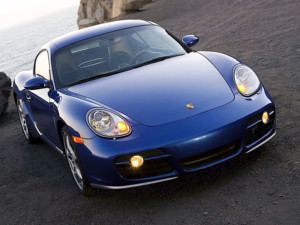 The Porsche Cayman is a highly desirable entry point to Porsche coupe ownership. It’s a superb small two seat coupe that handles nicely, is well balanced and looks like a Porsche!
The Porsche Cayman is a highly desirable entry point to Porsche coupe ownership. It’s a superb small two seat coupe that handles nicely, is well balanced and looks like a Porsche!
All generations of the Cayman are easy to drive, park and have fun in. The ride quality and handling has improved through the versions, but even the original Cayman is nimble and bags of fun to drive. The original version is somewhat under powered and the auto transmission is sluggish. Later versions, especially the 3.4L S, certainly have a bit more zip about them, but in general the Cayman was designed to not compete with the 911, so it will always be a little behind in performance. The introduction of the PDK transmission on the second version makes a significant driving difference.
From a practical standpoint, there’s not much you can do other than enjoy driving it every day. The Cayman is really the first practical version that can comfortably be an everyday driver. There’s more room in the Cayman for “stuff,” with two luggage spaces – one in front and one in the rear of the cabin. Space enough for your briefcase and still room to pick up groceries on your way home!
Early versions have plastic interior parts that can easily become discolored due to wear and tear. However, there is a healthy used parts market that can solve some of those problems easily. Generally, the interior is well laid out and practical. The later versions have better styled interiors than the original and the addition of touch screen navigation.
The Porsche Cayman has quite large tires. If the car you buy has 19-inch rims, you’ll be looking at approx. $1k for a set of 4 tires. The rear tires will wear quicker than the fronts on the Cayman due to suspension setup. It’s really important to stay on top of vehicle alignment – any loss of alignment on the rear of the Cayman will eat the inner shoulder of the rear tire rapidly. This is difficult to see because it’s so far under the car, but check it regularly or you’ll be buying rear tires way more often than you expect.
If your ownership plans include heading out for a track day (HPDE), then the Cayman is the place to start. On track, the car is well balanced and easy to drive quickly. The mid-engine setup and closer to 50/50 balance, makes it quite forgiving when you get ahead of yourself with the loud pedal! Go manual transmission for the track.
Which Porsche Cayman Would We Buy?
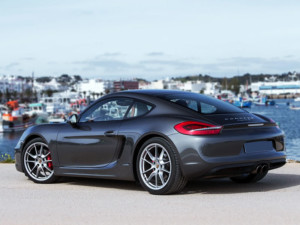 There was a time when the Cayman was riding high in the Porsche sales figures. However, the passing years have seen a steady decline in popularity, with the newer 718 sales (which include the Boxster) reaching a mere 4200 units in the USA for the whole of 2021. See our article Different Perspectives for more information.
There was a time when the Cayman was riding high in the Porsche sales figures. However, the passing years have seen a steady decline in popularity, with the newer 718 sales (which include the Boxster) reaching a mere 4200 units in the USA for the whole of 2021. See our article Different Perspectives for more information.
The Porsche Cayman is a wonderful choice for practical everyday Porsche motoring. Most recently, demand for the used Porsche Cayman has increased and available good examples are becoming rarer. Right now, the early 987 version is the likely candidate for best value for money. The balance with the Cayman used price, is always what kind of 911 can you buy for the same money?
Later used Cayman 987 S versions are selling in the high twenties for vehicles with lower mileage. This is a lot of car for the money – most of the issues with the Cayman were worked out of the design by the time the later 987 reached the showroom. The 718 version currently attracts a lot of money and we’d buy an older 911 instead of a similar priced later 718 Cayman.
There is a distinct shortage of cars in the 2008 through 2012 model years. Sales in these years were very flat after the housing bubble burst, so a short supply of good used cars exists from this period. However, all Cayman are holding their value well with most trading at higher money than the similar Boxster of the same year. The Porsche Cayman is the car that will always keep it’s value and resell easier than the Boxster.
Don’t buy an early automatic Porsche Cayman! The early automatic transmission version with a 2.7L engine is just plain dull and not worth the money being asked. It’s still a great car and can manually be told to change gear, but you miss the sports car zip feel with the auto trans. Three pedals on a early 987 is always best.
So, if you’re in the market for buying a used Porsche Cayman what should you be paying attention to before you commit to buy?
Mechanical Issues – What To Look For on a Porsche Cayman?
Fault Codes and Over-Revs – All Chassis
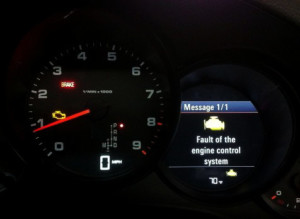 Before buying any car, it is essential to know when the last time the system fault codes were cleared and to check the status of the emission monitors. It’s not difficult for a seller to clear the faults just before you arrive for a test drive. Clearing the engine faults also resets the emissions system to a state of “not ready.” Emission readiness tests often occur over multiple drive cycles. So, after a reset, faults may not return for a significant number of miles. Again, this is easy for a competent shop to check or indeed the DIYer using a handheld scanner.
Before buying any car, it is essential to know when the last time the system fault codes were cleared and to check the status of the emission monitors. It’s not difficult for a seller to clear the faults just before you arrive for a test drive. Clearing the engine faults also resets the emissions system to a state of “not ready.” Emission readiness tests often occur over multiple drive cycles. So, after a reset, faults may not return for a significant number of miles. Again, this is easy for a competent shop to check or indeed the DIYer using a handheld scanner.
How hard has the car been driven? Taking the engine to the red line for RPM is a good thing, but going over the red line obviously can cause damage. A gear change at red line will actually cause the revs to increase slightly momentarily – nothing bad here. But, if you select the wrong gear, the engine revs to go way over the red line. This is the famous “miss-shift” that has caused many engine explosions.
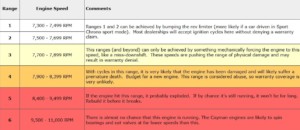 Thankfully, Porsche engine management records many things – one of the most significant is an over-rev situation. Data is permanently stored within the ECU showing running hours and when engine events have occurred. There are six levels of over-revs recorded, ranging from the engine being red-lined through to what would be a potentially catastrophically high RPM event. Events in the first category suggests the car has been properly exercised, but events in the higher categories could be hiding a potential life shortening engine situation.
Thankfully, Porsche engine management records many things – one of the most significant is an over-rev situation. Data is permanently stored within the ECU showing running hours and when engine events have occurred. There are six levels of over-revs recorded, ranging from the engine being red-lined through to what would be a potentially catastrophically high RPM event. Events in the first category suggests the car has been properly exercised, but events in the higher categories could be hiding a potential life shortening engine situation.
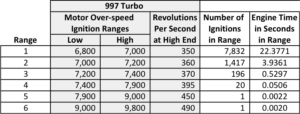 Many Porsche owners like to go to track days. On the track, gear changes will occur right around the rpm maximum red line. These events will be recorded if they reach the lower levels of the over rev counter. Multiple recorded events in the lower over-rev categories could be a sign of how much track time the car has experienced.
Many Porsche owners like to go to track days. On the track, gear changes will occur right around the rpm maximum red line. These events will be recorded if they reach the lower levels of the over rev counter. Multiple recorded events in the lower over-rev categories could be a sign of how much track time the car has experienced.
IMS Bearing – Early Production 987 Models
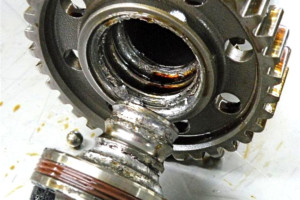 There’s a lot of hype about the IMS bearing failure associated with Porsche engines. The majority of failures occurred on the M96 engine used in the early 996 911 and 986 Boxster. In general the Cayman was shipped with the revised M97 engine that has an improved non-serviceable IMS bearing and does not suffer the failures associated with the early cars. There are however, some early M97 engines that do contain the serviceable IMS bearing that is prone to failure. These engines are restricted to the very early production cars – worth checking the production date stamped on the driver door for more clarity.
There’s a lot of hype about the IMS bearing failure associated with Porsche engines. The majority of failures occurred on the M96 engine used in the early 996 911 and 986 Boxster. In general the Cayman was shipped with the revised M97 engine that has an improved non-serviceable IMS bearing and does not suffer the failures associated with the early cars. There are however, some early M97 engines that do contain the serviceable IMS bearing that is prone to failure. These engines are restricted to the very early production cars – worth checking the production date stamped on the driver door for more clarity.
If you are looking at an early Cayman and the bearing has been replaced, there will be a sticker and serial number of the bearing in the engine lid. All the bearings are serial numbered and recorded with LN Engineering. If the bearing has been replaced in a manual car, you should expect to see that the clutch was replaced at the same time.
Don’t panic if the bearing hasn’t been replaced – reduce the cost of the car in negotiation and allow about $3K for doing the work. Again, despite the hype, less than 5% fail – all you need do is find a local Independent Porsche repair shop that can retrofit the IMS bearing for you.
Overheating – Cracked Cylinder Liners – 987
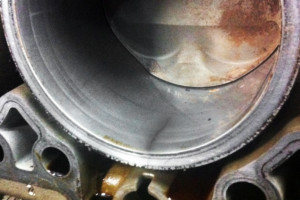 Each cylinder bore in the engine case half is lined with a one-piece sleeve or liner. The M97 flat 6 engines fitted in the 987 Cayman are subject to cracks in the liners of the cylinders.
Each cylinder bore in the engine case half is lined with a one-piece sleeve or liner. The M97 flat 6 engines fitted in the 987 Cayman are subject to cracks in the liners of the cylinders.
Results from a crack vary, but typically the most common is coolant loss with subsequent engine overheating. Sometimes, a crack in the cylinder liner can take a considerable amount of running time to fully open and cause problems. What can you do to find out?
First, note the coolant level when the engine is cold. Take your time here – you want to drive the car for 30 mins. After driving the car, let it sit and idle for a while. The front radiator fans should come on and the engine should maintain a steady temp. If the engine continues to warm and will eventually overheat, walk away.
Assuming all is well at this stage, turn off and take a look at the coolant level – it should have risen and be falling back toward the cold level. If the level has gone down or is still at the cold level, there could be a small coolant loss through a cracked liner. The trained nose can smell coolant from the exhaust when the engine is running. A Porsche repair shop can definitely help here. Note, this isn’t a definitive test because you could be loosing coolant through an external system leak. Any loss of coolant after a drive cycle should be thoroughly investigated.
Cylinder Scoring – The Deadly Knocking Noise – 987 & 981 Models
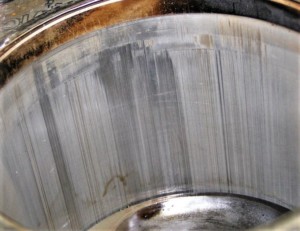 Lift the car and have a listen from below while the engine is running. You might need a repair shop to do that for you. You’ll hear the flat 6 engine in the Cayman make a consistent ticking sound.
Lift the car and have a listen from below while the engine is running. You might need a repair shop to do that for you. You’ll hear the flat 6 engine in the Cayman make a consistent ticking sound.
Much of this sound is the proximity of your ear to the valve train and the exhaust headers. However, there is a distinctly different sound that identifies with this particular issue that you don’t want to hear!
These engines are famed for cylinder scoring – deep gouges in the cylinder liner, usually associated with a knocking noise and eventually catastrophic engine failure. The root cause of this issue is open to discussion, however, wear in the piston rings and liners causes the piston to wobble. The wobble occurs at the bottom of the stroke and results in the piston skirt dragging against the cylinder wall thereby scoring the liner.
The sound your listening for is not a tick; it’s a rhythmic knock and usually shows up first on the passenger bank of the flat 6 engines – although, it can appear on any cylinder. The rhythmic knock is the piston changing position at the bottom of the stroke and hitting the liner. In many cases, even with the head off the engine, the scoring cannot be seen until the piston is removed – it can be way down at the bottom of the cylinder below the lowest point the rings meet the walls. Sometimes it can be seen by scoping down the spark plug tube, but the best view without disassembling the engine, comes from removing the oil pan and scoping from the inside.
If you hear this noise and the price of the car is zero dollars, you’ll still need approx. $20K to fix the problem!
Cam to Crank Timing Deviation
Timing is everything; especially in comedy and engines! The opening and closing of valves, the piston rising and falling in the cylinder and a spark are required at precise times during an engine rotation.
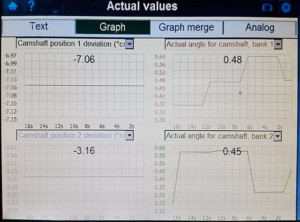 The major moving parts are connected by chains and these ensure the relationship between those moving parts is maintained regardless of the rotational speed. The rotation is measured in degrees of a full circle. So, for example, at degree zero; piston 1 should be at the top of the cylinder and the intake and exhaust valves closed. This is known as top dead center or TDC.
The major moving parts are connected by chains and these ensure the relationship between those moving parts is maintained regardless of the rotational speed. The rotation is measured in degrees of a full circle. So, for example, at degree zero; piston 1 should be at the top of the cylinder and the intake and exhaust valves closed. This is known as top dead center or TDC.
Naturally over time, the components supporting those timing chains will wear – the chain itself, guide rails, tensioners etc. will all wear and cause a deviation in the precise timing angles between camshafts and crankshaft. The engine management system is measuring the angles in every rotation and within a range of angles, can adjust the timing of fuel delivery and spark to compensate for wear changes. However, extended wear can produce an angle outside of the allowed deviation range and a fault condition will be set.
The earlier engines experienced issues with stretching timing chains and significant wear on the timing guide rails. This caused a nasty rattle at startup and generally set faults during acceleration. Most of these issues were corrected in later cars, but during the life of an engine you should expect that these vital timing components to wear.
You need a clear picture of where the used vehicle you propose to buy is in this wear process. A competent Porsche repair shop can tell you what the deviation angle between the cam and crank is during a used car inspection. This is a simple read from a diagnostic device and a clear indicator as to the health of the engine timing.
The change in angle will affect performance and is almost certainly not something you could pick up on during a test drive of an unfamiliar car. Replacing the chains, guides and tensioners to correct this problem is not an inexpensive proposition – it is however, relatively straightforward if your budget allows.
Potential Oil Leaks
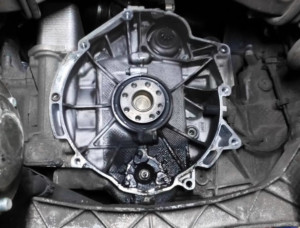 There are some common areas where oil leaks occur. Most are easily fixed and are part of the normal wear and tear. One of the most common areas for an oil leak is the rear main seal. Again, see our common problems page for more information. Oil leaks should not be a barrier to purchase, but they should be considered in terms of the purchase price and the cost of the repair.
There are some common areas where oil leaks occur. Most are easily fixed and are part of the normal wear and tear. One of the most common areas for an oil leak is the rear main seal. Again, see our common problems page for more information. Oil leaks should not be a barrier to purchase, but they should be considered in terms of the purchase price and the cost of the repair.
Leaking oil used to just be seen as a annoying stain on the driveway and a minor fire hazard. However, modern cars feature many electronic engine management systems that can potentially be severely damaged by oil ingress. What appears to be a minor oil leak could turn into an expensive electrical systems job if not addressed promptly. Again, this is where a competent shop should be able to accurately asses and relay the cost of an oil leak repair for you.
Suspension and Tire Wear on the Porsche Cayman
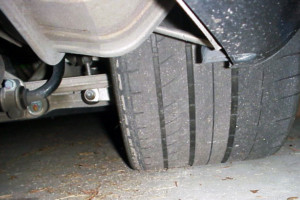 The suspension on the Cayman is very solid. Naturally, over time and mileage wear can occur in plastic or rubber bushings that help to cushion or support the ride. Listen out for squeaks or clunks over bumps and check for fluid leaks from the suspension struts.
The suspension on the Cayman is very solid. Naturally, over time and mileage wear can occur in plastic or rubber bushings that help to cushion or support the ride. Listen out for squeaks or clunks over bumps and check for fluid leaks from the suspension struts.
Worn suspension components can typically show up as uneven tire wear. Check the tires thoroughly for smooth wear patterns. In particular, take a good look at the inside of the rear tires. Weakness in the suspension joints, wear in the bushings or a simple alignment problem can very quickly eat expensive rear tires.
Pay attention to the tire DOT date. This is the date the tires were manufactured and is expressed in two numbers. For example, a DOT of 2312 means the tire was produced in the 23rd week of 2012. You’ll want to see a date that is no more than 5 years earlier. Low mileage cars in particular have this problem – the tires do not experience wear because of the lack of mileage. However, tires have a shelf life and will degrade while they sit – lots of tread doesn’t always mean a healthy tire. A tire that is more than 5 years old, could rapidly degrade or fail when you’re driving, despite the amount of tread remaining.
Transmission & Clutch
The manual and automatic transmissions on the Cayman are generally highly reliable. Both should change gear smoothly and without any hesitation. The auto transmission can be scanned for faults but rarely has issues. Fluid services can be performed on both transmissions and the duration of the time interval is quite high. Look for previous indications this has been done or understand where the car is in terms of time related fluid changes.
How long does a clutch last?
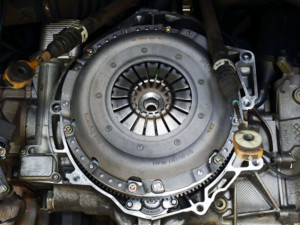 The answer depends on who is driving the car! We’ve seen customers destroy a clutch in 15K miles and we’ve also seen many that have more than 100K miles on them. Wear on the clutch should be very noticeable. Engine revs will increase while the car does not accelerate. This is usually associated with a nasty burning smell. A slipping clutch spells trouble.
The answer depends on who is driving the car! We’ve seen customers destroy a clutch in 15K miles and we’ve also seen many that have more than 100K miles on them. Wear on the clutch should be very noticeable. Engine revs will increase while the car does not accelerate. This is usually associated with a nasty burning smell. A slipping clutch spells trouble.
When the clutch slips it very quickly does damage to the flywheel. Replacing the flywheel on the Cayman is simple during the clutch work, but typically adds $700 to the overall cost in parts alone! Check the used Cayman you plan to buy for clutch replacement history and plan to have to do the work at some point in the future.
Porsche Cayman Brakes
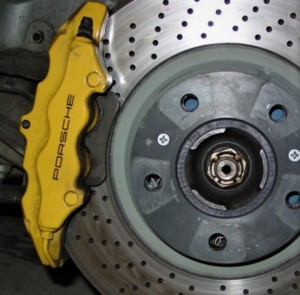 The brakes on the Cayman are generally excellent. Brake pad material does degrade over time, so again, on low mileage examples check to see when the last brake service was performed. The brake fluid should be changed every few years regardless of mileage.
The brakes on the Cayman are generally excellent. Brake pad material does degrade over time, so again, on low mileage examples check to see when the last brake service was performed. The brake fluid should be changed every few years regardless of mileage.
A complete brake service with pads, rotors and sensors can be quite expensive. So, if you’re buying from a used car vendor, look for new pads on old rotors. Both the pads and rotors should always be changed at the same time. Used car centers are famed for just replacing the pads and leaving on the old rotors. “The car has new brakes” – not if the rotors weren’t changed it doesn’t.
There should be a wear lip on the rotor and the size of that lip will determine how much mileage remains. Worn rotors crack or disintegrate, which can be particularly unpleasant when driving!
Most Cayman came with drilled rotors. Look carefully to see how clear the holes are in the rotor and make sure there are not cracks between the drill holes. Cracks between the drill holes can lead to a much bigger crack and quickly result in rotor failure under heavy braking.
Coolant Radiators and Air-Conditioning Condensers
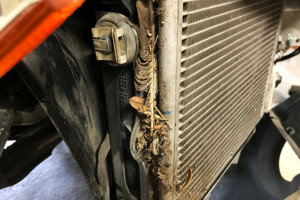 The design of the Cayman has the placement of the coolant radiators and air-conditioning condensers low down in the front bumper. The position and open vent nature of the design leaves them not only susceptible to stone impacts, but also to buildup of debris and dirt stuck close to the side of the radiators.
The design of the Cayman has the placement of the coolant radiators and air-conditioning condensers low down in the front bumper. The position and open vent nature of the design leaves them not only susceptible to stone impacts, but also to buildup of debris and dirt stuck close to the side of the radiators.
These front ducts and debris need to be cleaned out regularly or protected by an aftermarket screen. The front bumper has to be removed to reach the radiators and most owners never do it.
Take a flash light and look closely to see whether the front air intakes are full of rotting leaves and debris when you inspect the Cayman. Look closely, the debris will be around the sides of the radiators.
Damaged or corroded radiators and AC condensers cannot be repaired and must be replaced.
To Buy or Not To Buy a Porsche Cayman
The older Porsche Cayman is a tremendous way to enter the Porsche coupe ownership world. The Cayman is extremely pretty, so look past the sparkle and do your research.
We think the Porsche Cayman has been overlooked and under sold. Finding the right car is never simple, but with some luck and armed with the right information, you can pickup a bargain. Ten year old cars with reasonable mileage are available for less than 25% of their original cost!
We strongly recommend making friends at your local Independent Porsche repair shop before you buy.




